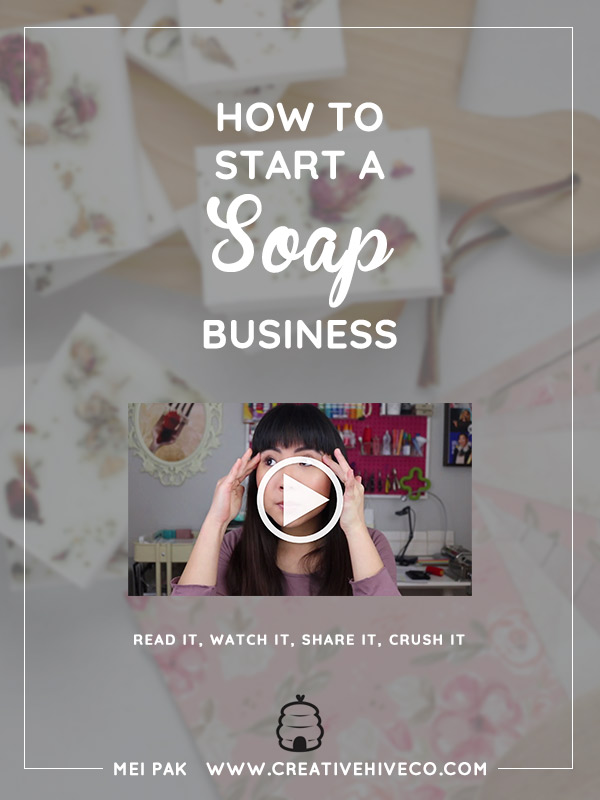I want to help you build a sustainable, profitable handmade business that makes you consistent income and sales. I only ever teach or recommend marketing, social media, pricing, production and branding tips that I’ve personally used successfully in my own 7-figure handmade businesses.
I'm Mei, from Los Angeles!
Read More
Popular Posts You'll Love
Looking for something?
Categories
starting a business
get more traffic
running a business
make more sales
branding
growing a business
mindset & productivity
podcasts
pricing & money
product photography
reviews
selling on etsy
selling on amazon
social media
selling wholesale
- Facebook1
- Twitter3
- Pinterest131
- 135shares
Today, I’ll be showing you a peek into the handmade soap industry. Is it a complete wash or can you clean up and make a good-looking profit?
I’ll also be sharing with you how you can start your own handmade soap business from home.
Why would you want to make soap?
People have been making soap at home for centuries, either for practical use or in more recent times just as a creative outlet. Besides making money off of it, it can actually be quite fun to do as well!
Soap is pretty simple to make. It’s made from a mixture of oils, lye, water and other optional additives like fragrances. All of these can be sourced from wholesalers and do not require any special licenses for you to make and sell.
There’s a lot you can do with soap. You can appeal to a variety of different audiences by using all-natural ingredients or by using exotic fragrances.
Some soaps even may have health benefits and can be molded into different fun shapes or just smell amazing. Just be sure not to make any unfounded claims to avoid negative feedback or worse, you don’t want the FDA knocking at your door.
Another great reason you might want to start a handmade soap business is that soap can usually be bought for personal use or given away as gifts throughout the year.
Soap sales are not limited to specific time periods or places, unlike items such as hats, scarves, and mittens.
People need to clean themselves (or at least they should), all-year round and even during a recession, like the one we’re experiencing right now due to the coronavirus. This necessity translates into steady sales, repeat business, and consistent income if people like your product.
Soap Stats
So here’s a crazy statistic for you. The global soap market is worth an estimated 18 billion US dollars.
A growing sector within that market belongs to just organic soap, which is expected to reach a value of $383.4 million USD by year 2025.
More people are looking for natural products that don’t contain harsh chemicals, aside from the sodium or potassium hydroxide, otherwise known as ‘lye’, which is used in the soap making process.
Most handmade soaps contain herbs, essential oils, and organic items to create one-of-a-kind products. Handmade soaps also can include glycerin, which helps to soften and moisturize the skin.
If you’re new to soap making then I really recommend checking out thesprucecrafts.com or Royalty Soaps on YouTube. They lay out the different methods you can use and walk you through the process for each one.
I’ll quickly run through some of the pros and cons for each method, but when it comes to actually choosing one and making the soap, you should definitely check them out as they provide excellent tips for free.
The Four Methods of Making Soap at Home
There are four main ways you can go about making soap at home. These are ‘melt and pour’, the ‘cold process’, the ‘hot process’ and a ‘rebatching process’. The first two are the most popular, as a hot process or rebatching are considered to be more advanced.
1. Melt and Pour
Melt and pour is essentially just melting pre-made soap and adding your own fragrance to it. It’s good for beginners but doesn’t give you much room for creativity and the end result is only as good as the soap you start with.
2. Cold Process
The cold process involves making soap from scratch using oils and lye. You’ll need to be careful when using ingredients like lye since it is a caustic substance. Sites like brambleberry.com specialize in cold process soap making and provide safety tips too. Definitely check that out if cold process soap making is on the agenda.
3. Hot Process
The hot process is similar to the cold process but requires heating the soap in an oven or slow cooker.
4. Rebatching
And rebatching involves grinding up and re-blending batches of poorly made handmade soap.
The cold process is the most highly recommended soap making method for a sustainable home business. Soaping 101 on YouTube is a great channel to check out for cold process free recipes.
It’s a good idea to do a test run so you can get an idea of the process, which ingredients and materials you’ll need and whether soap making is or isn’t for you. If you decide you don’t like soap making, then don’t worry, at least you’ll know and then you can check out some of the other business ideas.
Supply Chain
Next thing I want to talk about is your supply chain. You’ll want to know the best places to buy ingredients in bulk at wholesale prices. Many sellers find it easier and cheaper to source oils such as olive oil and coconut oil from places like Costco and Amazon.
For other supplies like lye, colorants and fragrances, brambleberry.com has really great reviews within the community, as well as Nature’s Garden and wholesalesuppliesplus.com. I’ve personally bought my fragrance oils from both these sites and had a great experience.

Selling Your Soap Online
Now, once you’ve taken the time to choose your market and who you want to sell to, you’ve sourced your materials and you’ve honed the craft, it’s time to start selling your soap online and making some money.
As always, my advice is that you should start and build your own website on a platform like Shopify.
That’s going to be your best bet at building a business that’s long term, sustainable, and one that you control. You can also eventually get into selling your soaps wholesale to other stores. You should check out selling on marketplace sites like Etsy or Amazon who both have a huge built-in audience for you to sell to.
I know I just made that sound like a no brainer to go sell on Etsy or Amazon, but before you do, make sure you watch my pros and cons video because you don’t want to put all your eggs in either Etsy or Amazon.
I’m a big fan of the Fulfilment By Amazon (FBA) service and I know a lot of people love using that too. It’s particularly beneficial to you as a shop owner once you start selling in high quantities. It may cut into your profits slightly, but being able to ship your stock to an Amazon warehouse where they package and send to customers themselves so you don’t have to, will save you lots of time and effort that can be better spent growing your business.
Also, being able to apply the Amazon Prime logo to your listings opens up a whole new audience of potential buyers. It’s really great!
You might also want to consider drop-shipping your soaps. This is when your items are advertised on someone else’s site and sold to their customers, but the company doesn’t actually carry any of your physical stock. You’re still responsible for sending the item to the customer.
Both you and the retailer split the earnings from the sale at around 50% each. This can be incredibly lucrative if you find the right dropshipping partners and the nice thing about it is you don’t have to worry about marketing or advertising.
Listing Your Product Online
When it comes to listing your soap online, you really need to communicate their properties clearly to the customer. Soap is a pretty intimate product, it’s all about how it feels and smells and that can be hard to get across to people online since smell-o-vision hasn’t been invented yet. Be sure to take between 5 to 10 clear photographs of each of your products, with and without packaging.
Online search engines operate using algorithms and it’s all about matching a buyer’s search to keywords and phrases. You’ll need to use relevant words and phrases that are likely to get hits in the title of your product and its description.
Everything from color, fragrance, texture, moisturizing effects and anything you can think of that relates to your soap, you’ll want to write that in your product description.
At the same time, buyers don’t want to scroll through walls of text. Try to find a balance between making it as concise and as informative as possible.
Pricing
Another factor that could potentially scare off customers, or entice them, is the price of your bars of soap.
People tend to value the “handmade” aspect of a product and are willing to pay a little bit extra for it.
However, be wary that in a congested market such as Amazon, people have a lot of options and will often go for the cheaper option if another looks vaguely similar. Amazon does have a handmade platform but in my experience sales do not benefit from it as much as on the standard Amazon site.
The good thing for you is, soap is very cheap to make. A 3.5 ounce or 100-gram bar of soap should cost you anywhere from 50 cents to $1.50 to produce, depending on the wax and fragrances you use.
For a bar of that size, you can expect to sell it for around $4 to $5 or approximately 4 to 5 times the amount it cost you to make it. This may sound like a small amount but there are ways to increase how much you earn.
Making bigger bars or offering value or ‘tester’ sets which include a range of different smells, means you can sell more product in higher quantities.
Not to mention, if you have great branding and customer experience, you could even charge $10 to $12 for a bar of soap!
Shipping
You’ll also need to consider the cost of shipping your soap products. Soap can get quite heavy, so if you’re in the US, definitely take advantage of USPS’ flat rate shipping boxes. You pay a flat fee regardless of how many soaps you’re shipping.
You’ll also want to think about how to package and protect your soap so that it doesn’t get damaged in transit. Other soap sellers have suggested using shrink wrap, bubble wrap or tissue paper.
Before you sell online, or even as you’re gearing up to sell online, it may be a good idea to test your product at a craft show or live event. That way you can interact with customers, ask them questions, get genuine feedback, and ultimately, tweak your product if you need to.
Selling soap isn’t about huge profit margins and you should definitely not look at it as a get-rich-quick plan, however, it is a great way to have fun and get creative while also learning about handmade businesses and selling online.
It’s very possible to break through the saturated market and make a living from it, but you will need to stand out from the crowd and make good strategic choices along the way.

Leave a Comment
Liked this article? Share it!
Unlock a Profitable Handmade Business
in Just 12 Weeks Without Using Etsy
or Social Media
FREE WORKSHOP
This workshop is for anyone who makes and sells a handmade or physical product, including jewelry designers, artists, paper designers, bath & body product makers and more!
What You'll Discover
The #1 mistake people make with Etsy & social media that causes shops to FLOP
The secret to making it with your handmade shop so it's no longer just a hobby
How to make sales in your handmade shop with ease so you can finally get to 6-figures
TAKE ME THERE
Your email address will not be published. Required fields are marked *
Leave a Reply Cancel reply
About
Blog
A Sale A Day
Student Login
Free Class
Contact
Terms
Become A Student
Watch On YouTube
Student Reviews
See My Handmade Shop!




Thanks for sharing these tips. They make a beautiful gift, especially the 100% natural ones, since they tend to be more expensive. And the smell is amazing!
I am planning to start my own soap business and thanks to you i now have a idea on how to start and where to get items plus videos so thank you so much
I think finding a good supply chain is hard for me. Thanks for sharing these useful guidance